密封基础知识(基本结构)讲解
- 格式:ppt
- 大小:6.84 MB
- 文档页数:107
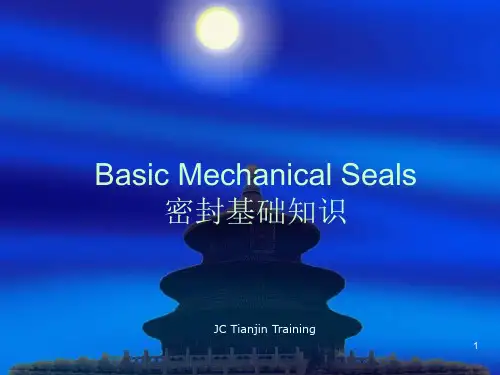
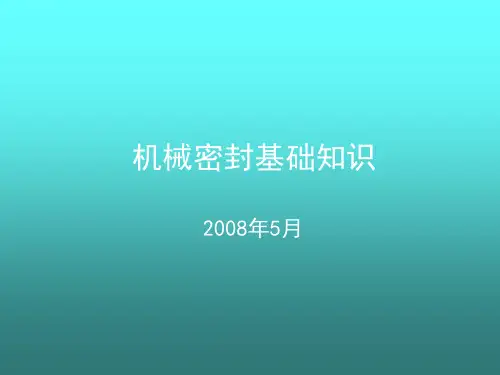

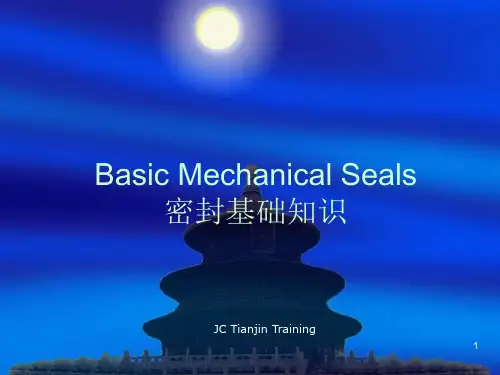
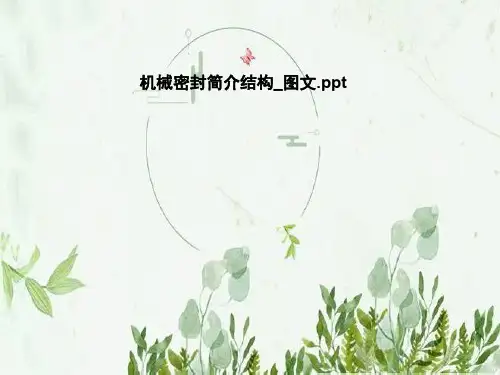
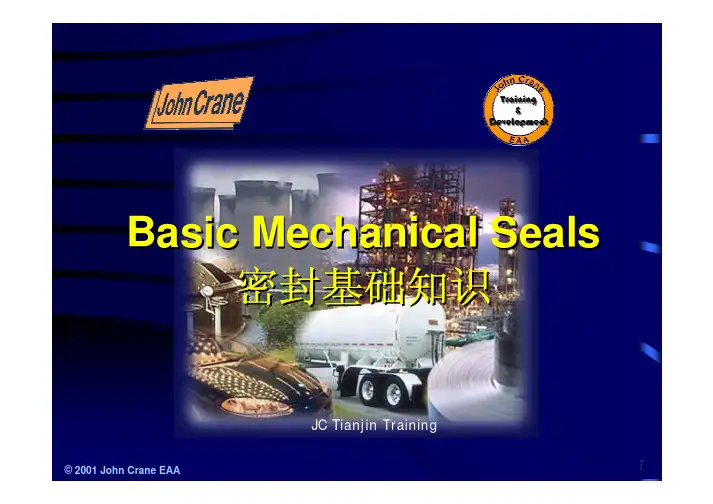
Basic Mechanical Seals 密封基础知识JC Tianjin Training© 2001 John Crane EAA1 1What is a mechanical seal?什么是机械密封? two flat sliding surfaces, which maintain a close running clearance while separated by a fluid film两个平滑表面中间有干净液膜隔离,保持贴合运转rotating seal unitstationary seal unit2 2Desired Features of a Seal 机械密封必须有的特征Small axial clearance 小的轴向间隙 Self adjusting 自调节Shaft Movement 轴的运动Long-life 很长的寿命 Easy maintenance 容易检修 Low cost 低成本Basic Mechanical Seal基础机械密封1Loose ring set screwed to the shaft4 4Basic Mechanical Seal基础机械密封2Wear here will create leakageO-ring prevents leakage through the bore5 5Basic Mechanical Seal基础机械密封Heat generated here 此处生热 Leak path3Large component 大零件Spring ensures automatic adjustment 弹簧确保自动调整6 6Basic Mechanical Seal基础机械密封Recirculation for cooling4Gasket or O-ring 垫片或者O型圈Secondary Seal Tertiary Seal Primary Seal 三次密封 二次密封 主密封7 7Basic Mechanical Seal基础机械密封Spring or Spring Force5Seat or Mating RingFace or Primary Ring8 8Basic Mechanical Seal基础机械密封SPRING OR SPRING FORCE Recirculation for cooling Gasket or O-ring SEATSecondary Seal Primary SealTertiary Seal9 9An Example of a Complete Seal一个完整密封的例子Primary Ring补偿环 Snap Ring卡环 Anti-X Ring 挡环 O-Ring O型圈 Disk推环 Springs弹簧 Retainer传动套 Set Screw定位螺丝 Mating Ring 配合环 O-Ring O型圈Shaft轴Simply put, a mechanical seal is: 简单的说,机械密封就是:1. A wearable, stationary, primary sealing element 一个耐磨,静止的密封件 2. A wearable, rotating, primary sealing element 一个耐磨,旋转的密封件 3. A secondary sealing element 二次密封 4. A mechanical loading device to press primary sealing elements 1 and 2 against one another, and 使件1和件2相互贴合的机械装置 5. Auxiliary components to complete seal 辅助密封Gland Packing v. Mechanical Seals 盘根和机械密封不像一个机械密封而更像 一个限制装置,需要泄漏否 则将会灼伤. 会磨损轴或轴套 高功耗用来克服磨擦 产品损失 需要大量的水 安装,维修和盘根调整需要 停车时间 泄漏导致设备破坏和摧毁 不可见泄漏、机械密封和盘 根之间的泄漏率在1到100或 者更好 证明机械密封的寿命可达8 到10年毫无故障 无产品损失,节省水和能量可 以节省成本 安装后维修很少 密封有潜在危害的物质时机 械密封可以提供更好的安全 性12 12Primary Seal 主密封a thin film of liquid forms the primary (dynamic) seal between the rotating and stationary elements FILM REACTIONSPRING FORCE FLUID PRESSUREfluid film (3 - 5 microns)13 13Primary Seal – Film Thickness 主密封——膜厚度Faces lapped flat to within 1 - 3 light bands.14 14Primary Seal – Film Thickness 主密封——膜厚度Fluid film thickness is very importanttoo thin - wear, causing early seal failure too thick - visible leakageMust be:present - beware dry running stable clean - beware abrasive wear symptoms reasonable viscosity temperature controlled acceptable pressure15 15Primary Seal – Face Flatness 主密封——平面If faces not flat, contact generates heat Excessive wear - short life 如果密封面不平,接触摩擦生热,密封磨损快、寿命短 1 light band = 0.0000116 inch or 0.0003 mm16 16The Sealing Interface 密封面Lubrication Purpose: 润滑目的Separate surfaces 分离两个面 Prevent contact of high surface points 防止摩擦面高点接触 Reduce friction/heat generation 减少摩擦/生热Magnified Surface A 放大面Separation 分离面Lubricant 润滑剂Heat 热量Magnified Surface B 放大面Process Fluid Acts as Lubricant Between Faces 流体在两个面之间充当润滑剂的过程Pump Housing 泵腔 Process Fluid 工艺流体 Gland 密封端盖Primary Ring 补偿环Mating Ring 配合环Invisible Leakage: 不可见泄漏 Fluid Evaporates Upon Reaching Atmosphere 微量的泄漏在大气侧蒸发Without Lubrication, Faces Run Dry And Overheat 没有润滑干运转导致过热Pump Housing 泵腔 No Fluid Or Dry Running 没有流体或者干运转 Gland 密封端盖Primary Ring 补偿环Mating Ring 配合环常用动环材料Face (Primary Ring) Materials 动环材料Carbon-graphite 碳石墨类 resin impregnated 树脂浸渍 (171) antimony impregnated 金属锑浸渍 (218) Carbon converted to Silicon Carbide 硅化石墨(121) CVR 化学汽相反应硅化石墨 CVD 化学汽相沉积硅化石墨 Solid Silicon Carbide 碳化硅 Sintered silicon carbide 无压烧结碳化硅 (277) Reaction silicon carbide 反应烧结碳化硅(088) Sintered silicon carbide with controlled porosity 微孔碳 化硅 (584) Tungsten Carbide 碳化钨 Cobalt bonded 钴基碳化钨(025) 20 Nickel bonded 镍基碳化钨(005) 20常用静环材料Seat (Mating Ring-Narrow) Materials 静环材料Ceramic 陶瓷 99.7% Aluminium Oxide 氧化铝 (059) Solid Silicon Carbide 碳化硅 Sintered silicon carbide 无压烧结碳化硅 (277) Reaction silicon carbide 反应烧结碳化硅(088) Sintered silicon carbide with controlled porosity 微 孔碳化硅 (584) Tungsten Carbide 碳化钨 Cobalt bonded 钴基碳化钨(025) Nickel bonded 镍基碳化钨(005)21 21Secondary Seal 二次密封Three basic forms 三种基本形式o-rings o型圈 Wedges 楔形环 Bellows 波纹管 Elastomer 橡胶的 Metal 金属的Formed 成型的 edge welded 焊接的Two groupsPusher推进式sliding o-rings wedges Non-pusher非推进式bellowsPTFE22 22Secondary Sealing Elements 二次密封Elastomeric Bellows 橡胶波纹管 Half Convolution 半波 Teflon Bellows 聚四氟乙烯 波纹管 Welded Metal Bellows 焊接金属波纹管V Rings V型圈U Cup 杯型Wedge 楔形Encapsulated O Ring 包覆 O型圈O Ring O型圈Pusher vs. Non-Pusher 推进式/非推进式Pusher 推进式 vs. Non-Pusher 非推进式O-ring secondary seal must slide along shaft as seal face wears O型圈二次密封在密封面磨 损的时候必须能够沿轴滑动Bellows secondary seal expands to accommodate face wear. Bellows tail is stationary against shaft. 波纹管伸长能够补偿密封面磨 损,波纹管尾部与轴保持静止Secondary Seal: Pusher 二次密封:推进式As the face moves forward to take up wear, the o-ring moves forward with the face, pushed by the hydraulic and spring pressures25 25Secondary Seal: Pusher 二次密封:推进式Advantages 优点sudden failure very unlikely 几乎不会突发意外事故 higher pressure capability - face not stressed wide choice of materials for all components 所有成分的材料选择广泛 field repairableDisadvantages 缺点hang-up (not likely where o-ring is well isolated) 挂起 permanent set / pressure problems (cause hang-up) excellent shaft surface finish required maximum temperature ~ +260°C 最高温度+260°C26 26Pusher Seal: Hang-up 推进式密封:挂起An external quench will prevent hang-upProduct leakage solidifies / crystallises / polymerises Prevents o-ring pushing forward - leakage increases27 27Secondary Seal: O-Ring 二次密封:O型圈Type 8B128 28Secondary Seal: Wedge 二次密封:楔形环29 29Secondary Seal: Non-Pusher 二次密封:非推进式Bellows flexes to take up wear, misalignment and axial play Fine machined shaft surface required Do not use a ‘good’ lubricant - never use silicon grease30 30Secondary Seal: Bellows 二次密封:波纹管No contact here 此处不发生接触Elastomer Bellows grips shaft tightly31 31Secondary Seal: Metal Bellows 二次密封:金属波纹管static o-ring 静止o型圈32 32Secondary Seal: PTFE Bellows 二次密封:PTFE波纹管Type 10TType 10R33 33Tertiary Seal 三次密封Tertiary Seal 三次密封Prevents leakage round mating ringSometimes also prevents mating ring rotation35 35Tertiary Seal 三次密封Four basic types 四种基本的形式O-rings O型圈 Elastomers 橡胶 Seat Rings (square or rectangular section) PTFE graphite Cup Rings elastomers Gaskets or Flat Joints PTFE compressed fibre36 36Tertiary Seal: O-ring 三次密封:O型环Tertiary Seal: O-ring 三次密封:O型环Tertiary Seal: O-ring 三次密封:O型环Tertiary Seal: Seat Ring 三次密封:静环40 40Tertiary Seal: Cup Rubber 三次密封:Spring Design Features 弹簧设计特点Springs 弹簧 Provide The Initial Closing Force 提供初始闭合力 Are Very Important At Low Pressures 低压下很重要 Are Not So Important At High Pressures 高压下不重要Design Features 设计特点Springs 弹簧 Single 单弹簧 Multiple 多弹簧 Bellows 波纹管 Wave 波形Design Features 设计特点Springs 弹簧 High Speed Seals Use Stationary Springs (5000 ft/min Typical Break Point) 高速机械密封使用静止弹簧 (5000ft/min 典型的分界点)Design Features 设计特点Springs 弹簧Corrosion 腐蚀 Clogging 堵塞 Uniformity Of Load 负荷一致 Inventory 库存Types of Drive Mechanisms 驱动机械的类型Drive Mechanism 驱动机械Must Transmit Torque 必须能够传递转距 Must Allow Axial Movement (Primary Ring) 必须能够使动环轴向运动Types of Drive Mechanisms 驱动机械的类型Dent Drive 凹轮驱动 Key Drive 键驱动 Set Screw Drive 定位螺丝驱动Pin Drive 销驱动Snap Ring Drive 卡环驱动Slot and Ear 缝和支耳Elastomer Drive 橡胶驱动Spring Drive 弹簧驱动Design FeaturesBalance RatioBalance ratio is used to control the face load. Closing Force Opening ForceDesign FeaturesBalance RatioBalance ratio is the ratio of the closing area to the opening area. A cAoClosing Area Balance Ratio = Opening AreaDesign FeaturesBalance RatioAn Unbalanced SealAcFcA o。
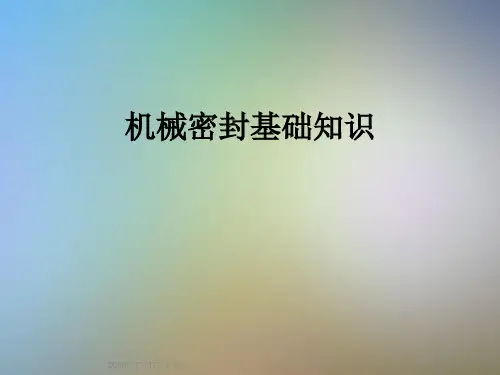
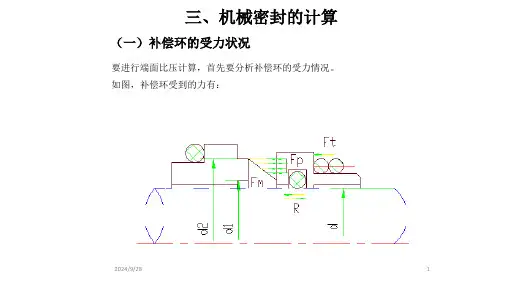
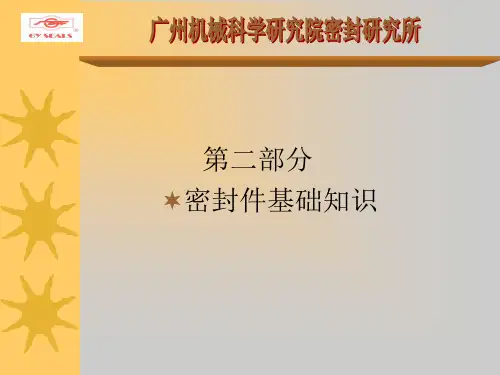
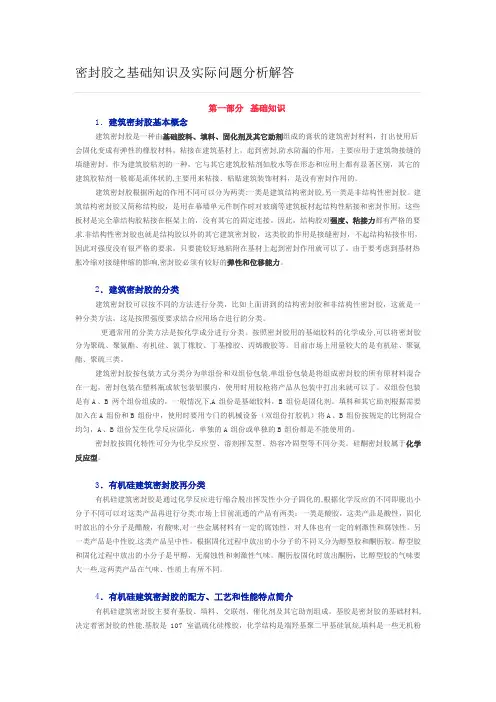
密封胶之基础知识及实际问题分析解答第一部分基础知识1.建筑密封胶基本概念建筑密封胶是一种由基础胶料、填料、固化剂及其它助剂组成的膏状的建筑密封材料,打出使用后会固化变成有弹性的橡胶材料,粘接在建筑基材上,起到密封,防水防漏的作用,主要应用于建筑物接缝的填缝密封。
作为建筑胶粘剂的一种,它与其它建筑胶粘剂如胶水等在形态和应用上都有显著区别,其它的建筑胶粘剂一般都是流体状的,主要用来粘接、粘贴建筑装饰材料,是没有密封作用的。
建筑密封胶根据所起的作用不同可以分为两类:一类是建筑结构密封胶,另一类是非结构性密封胶。
建筑结构密封胶又简称结构胶,是用在幕墙单元件制作时对玻璃等建筑板材起结构性粘接和密封作用,这些板材是完全靠结构胶粘接在框架上的,没有其它的固定连接。
因此,结构胶对强度、粘接力都有严格的要求.非结构性密封胶也就是结构胶以外的其它建筑密封胶,这类胶的作用是接缝密封,不起结构粘接作用,因此对强度没有很严格的要求,只要能较好地粘附在基材上起到密封作用就可以了。
由于要考虑到基材热胀冷缩对接缝伸缩的影响,密封胶必须有较好的弹性和位移能力。
2.建筑密封胶的分类建筑密封胶可以按不同的方法进行分类,比如上面讲到的结构密封胶和非结构性密封胶,这就是一种分类方法,这是按照强度要求结合应用场合进行的分类。
更通常用的分类方法是按化学成分进行分类。
按照密封胶用的基础胶料的化学成分,可以将密封胶分为聚硫、聚氨酯、有机硅、氯丁橡胶、丁基橡胶、丙烯酸胶等。
目前市场上用量较大的是有机硅、聚氨酯、聚硫三类。
建筑密封胶按包装方式分类分为单组份和双组份包装,单组份包装是将组成密封胶的所有原材料混合在一起,密封包装在塑料瓶或软包装铝膜内,使用时用胶枪将产品从包装中打出来就可以了。
双组份包装是有A、B两个组份组成的,一般情况下,A组份是基础胶料,B组份是固化剂。
填料和其它助剂根据需要加入在A组份和B组份中,使用时要用专门的机械设备(双组份打胶机)将A、B组份按规定的比例混合均匀,A、B组份发生化学反应固化,单独的A组份或单独的B组份都是不能使用的。
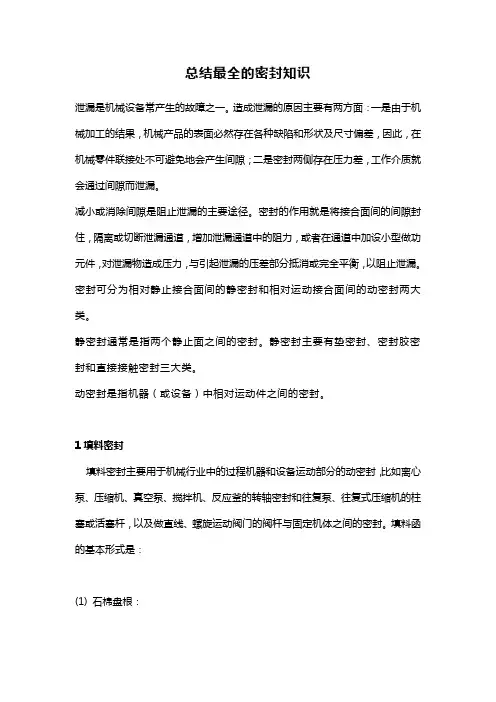
总结最全的密封知识泄漏是机械设备常产生的故障之一。
造成泄漏的原因主要有两方面:一是由于机械加工的结果,机械产品的表面必然存在各种缺陷和形状及尺寸偏差,因此,在机械零件联接处不可避免地会产生间隙;二是密封两侧存在压力差,工作介质就会通过间隙而泄漏。
减小或消除间隙是阻止泄漏的主要途径。
密封的作用就是将接合面间的间隙封住,隔离或切断泄漏通道,增加泄漏通道中的阻力,或者在通道中加设小型做功元件,对泄漏物造成压力,与引起泄漏的压差部分抵消或完全平衡,以阻止泄漏。
密封可分为相对静止接合面间的静密封和相对运动接合面间的动密封两大类。
静密封通常是指两个静止面之间的密封。
静密封主要有垫密封、密封胶密封和直接接触密封三大类。
动密封是指机器(或设备)中相对运动件之间的密封。
1填料密封填料密封主要用于机械行业中的过程机器和设备运动部分的动密封,比如离心泵、压缩机、真空泵、搅拌机、反应釜的转轴密封和往复泵、往复式压缩机的柱塞或活塞杆,以及做直线、螺旋运动阀门的阀杆与固定机体之间的密封。
填料函的基本形式是:(1) 石棉盘根:耐温和耐腐蚀性能都很好,但单独使用时,密封效果不佳,所以总是浸渍或附加其他材料。
油浸石棉盘根:它的基本结构形式有两种,一种是扭制,另一种是编结。
又可分圆形和方形。
(2) 聚四氟乙烯编织盘根:将聚四氟乙烯细带编织为盘根,有极好的耐腐蚀性能,又可用于深冷介质。
(3) 橡胶O形圈:在低压状态下,密封效果良好。
使用温度受限制,如天然橡胶只能用于60℃。
(4) 塑料成型填料:一般做成三件式,也可做成其他形状。
所用塑料以聚四氟乙烯为多,也有采用尼龙66和尼龙1010的。
(5)软填料密封软填料,又称泥状填料,是由新一代高性能合成纤维配以特殊的阻隔剂和润滑剂精制而成的高级“盘根”。
软填料的任意尺寸,任意形状,极易安装,通过专用的高压枪便可直接注射,不必象传统的盘根,需要预切割,能适用任何尺寸的填料腔密封。
软填料密封适用范围广泛,如高压往复泵或低转速泵、高温阀杆、阀或填料盒的密封。
设备门密封的种类及结构
1. 橡胶密封条,橡胶密封条是一种常见的门密封材料,通常由
橡胶或硅胶制成,具有弹性和耐磨损的特点。
它们可以安装在门框
或门扇上,通过与门框或门扇接触形成密封,防止空气、水汽或灰
尘的渗透。
2. 磁性密封条,磁性密封条通常由橡胶和磁性材料组成,可以
在门的边缘或底部安装。
它们利用磁性吸附力和橡胶的密封性能,
确保门与门框之间的紧密贴合,从而有效防止气体和液体的泄漏。
3. 挤塑密封条,挤塑密封条是通过挤压橡胶或塑料材料制成的,具有良好的弹性和耐候性。
它们常用于工业设备门的密封,能够有
效隔离噪音、灰尘和湿气。
4. 弹性密封胶条,弹性密封胶条通常由聚合物材料制成,具有
良好的弹性和粘附性能,能够在门与门框之间形成紧密的密封,防
止空气和水的渗透。
5. 膨胀密封条,膨胀密封条通常由橡胶或聚合物材料制成,具
有吸水膨胀的特性。
当受到水分浸泡时,膨胀密封条会膨胀成胶状
物质,填补门与门框之间的缝隙,形成有效的密封。
总的来说,设备门的密封种类和结构多种多样,选择合适的密封方式需要考虑门的材质、使用环境、密封要求等因素,以确保门具有良好的密封性能和安全性。